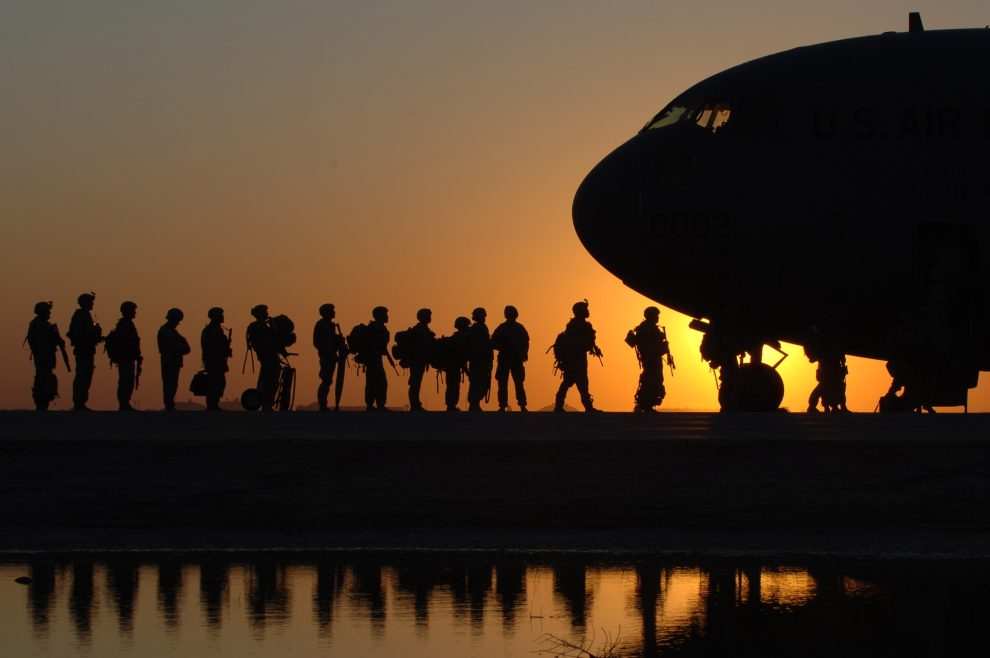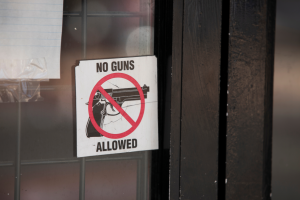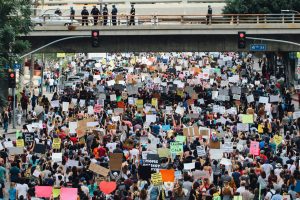For Catholic millennials the past decade of war has mostly remained out of sight and out of mind.
Caleb is a 22-year-old Navy veteran who headed to boot camp as soon as he graduated from high school and quickly found himself in Iraq, where he spent most of his time patrolling rivers. He’s also a devout Catholic; he and his wife attend Mass every week and serve as lectors at their parish. Caleb is a confident, experienced man, but when asked to speak about both of these things at once—his support for the war and his faith—he wavers. “We’re supposed to be, as Catholics, spreading our faith, loving everyone, and never doing wrong things, but in war, it’s not possible,” he says. “There’s the military and American part of me that’s supportive of the war, but the Catholic side says maybe we could do this differently. But I don’t know how.”
Caleb, who requested his last name be withheld, will graduate from college in December with a degree in history, and he hopes to head back to Iraq with a private security firm like Blackwater for a few years to earn enough money to support a family.
“As a Catholic, you’re supposed to be Catholic all the time, and that’s a very [noble] idea,” he explains. “But the truth is, I can’t do it. Life is more complicated than that. Religion plays a big part in my life, but when it comes to things like war, it gets complicated and fuzzy and gray.”
History of war
The American Catholic Church has a complicated history when it comes to war and peace. Activist Dorothy Day founded the Catholic Worker movement in 1933, and her small but vocal group provided rare opposition to the immensely popular World War II.
Although Pope Pius XII was appalled by the 1945 bombing of Japan, American Catholics overwhelmingly supported the war, much like the rest of the nation. Three thousand Catholic chaplains served in it, and Catholics made up a disproportionately high percentage of soldiers. Only 1 percent of conscientious objectors to World War II were Catholic. According to historian Kenneth Heineman, 80 percent of male Catholic Worker supporters abandoned pacifism when the war broke out.
American Catholics also overwhelmingly supported the invasion of Vietnam in 1965. But change was in the air. The first American demonstration against the country’s involvement in Vietnam was led by a group of young Catholic Workers in New York in 1963.
Conscientious objector Thomas Cornell, who had become involved with the group while attending a Jesuit university in Connecticut, led the group in that first protest. He had been inspired by Pope John XXIII’s 1963 encyclical Pacem in Terris (Peace on Earth), which proclaimed that in an era of nuclear weapons, waging just war becomes nearly impossible. In 1964 Cornell co-founded the Catholic Peace Fellowship with the goal of organizing protests and counseling young people on becoming conscientious objectors.
Catholic voices played a leading role in the growing anti-war movement. A young Catholic pacifist named David Miller burned his draft card on national television in 1965, and soon after, destroying the cards became a federal offense. He described it as “the best personal witness that I can give.”
In November of that year, ex-seminarian and Catholic Worker Roger LaPorte set himself on fire in front of the United Nations building. “I’m against war, all wars,” he said in a note left behind. “I did this as a religious action.”
The Catonsville Nine, all Catholic activists, burned hundreds of draft files with homemade napalm in 1968. The group included brothers Philip and Daniel Berrigan, both priests at the time, who spent time on the FBI’s 10 Most Wanted list for their activism.
In 1966 the National Conference of Catholic Bishops called for an end of military escalation in Vietnam.
Still, the average Catholic didn’t join the marches and protests. Anti-war Democrat George McGovern lost the Catholic vote in the 1972 election, and activists needled their hawkish fellow believers throughout the course of the war.
But the fact remains that the voices of young Catholics opposed to the Vietnam War 40 years ago were loud, public, and sustained, while comparatively few millennials are similarly speaking out against their generation’s wars.
The 9/11 generation
For the millennial generation—an imprecise classification that generally encompasses young adults born between 1982 and 2000, give or take a few years on either end—September 11, 2001, is considered the defining event.
“It’s one of those moments you never forget,” Patrick Roach, now a 31-year-old attorney in Washington, recalls. He watched the towers fall with 30 classmates in his college cafeteria. “It’s like how everyone from my parents’ generation remembers where they were for the Kennedy assassination. It was one of the most vivid moments of my entire life.”
Most of today’s 20-somethings were teens on September 11. As moral theologian Tobias Winright, who teaches at St. Louis University in Missouri, puts it, “They don’t really remember very well a time when there wasn’t war. In contrast to Kant’s ‘perpetual peace,’ their experience has been that life is one of perpetual war.”
Jennifer Adkins, a 22-year-old former student of Winright’s, puts that notion in starker terms. “I was scared,” she says of watching the towers fall on TV in her sixth-grade math class. “But the thing that really stuck out was that I was angry. That anger stuck with me until college.”
As awful as September 11 was, Americans shared a sense of righteous clarity in the immediate aftermath. But since that autumn day more than a decade ago, the United States has entered into two major wars, plus the war on terror, and sent troops into countries such as Pakistan and Libya. It has increased drone strikes in countries including Yemen, expanded the government’s power of surveillance, held suspected terrorists indefinitely in a detention facility in Guantánamo Bay, and maintained a system of “extraordinary rendition” that involves sending people overseas to countries that the international community acknowledges engage in torture.
Whatever you make of any of these actions, the U.S. has done plenty to arouse the interest, if not the ire, of engaged citizens committed to a culture of justice and life. But American Catholics largely supported the war in Iraq, at least at first.
A 2003 survey conducted by the Pew Research Center found that 62 percent of Catholics supported the invasion, compared with 44 percent of non-religious Americans. A 2005 Pew survey found American Catholics significantly likelier than the general public to say that torture is at least sometimes justified.
Many campus youth ministers, professors, activists, and young people agree that with a few exceptions—including the annual Catholic-led vigil at the Department of Defense’s controversial training School of the Americas in Georgia—young American Catholics seem relatively unmoved by the issues relating to war and peace that have dominated the last decade of foreign policy.
It’s just war
In the Catholic just war tradition, a legitimate war must fulfill several conditions, including that military action must be necessary, appropriate, and proportionate; the war must be waged only as a last resort; and there must be a reasonable chance of success. As the Catechism of the Catholic Church puts it, “The gravity of such a decision makes it subject to rigorous conditions of moral legitimacy.”
But though many young Catholics have at least heard the term “just war,” they don’t agree on what it means. Thomas James, a 26-year-old recent Catholic convert who teaches English and Latin at a private school in Montana, says he’s never heard just war theory preached from any pulpit in any church, Catholic or Protestant. “Our idea of what a just war is is informed less by religious instruction and more by secular history textbooks and the evening news,” he says. He supported the invasion of Iraq as a Protestant and says joining the Catholic Church didn’t change his perspective on this particular issue.
Church leadership has made it clear that the last decade of American foreign policy, particularly the war in Iraq, has not lived up to the just war ideal. The U.S. Conference of Catholic Bishops released a statement in November 2002 proclaiming that invading Iraq “would not meet the strict conditions in Catholic teaching for overriding the strong presumption against the use of military force.”
Pope John Paul II spoke frequently against the war and sent Vatican representatives to Washington to meet with President George W. Bush to try to change his mind. The Vatican called the eventual conflict “a defeat for reason and for the gospel” just a few hours after the first American missiles hit Baghdad. As late as 2004, Pope John Paul II insisted that violence is not the only response to terrorism.
In the summer of 2001 Michael Baxter, a theology professor and, at the time, a Holy Cross priest, helped relaunch the Catholic Peace Fellowship, which had fallen dormant in the early 1980s. The revived organization lives on, but Baxter says he’s noticed a sharp decline in the engagement of his students on war issues. “During the Vietnam War, when I was in high school, everyone was talking about it,” Baxter recalls. “Those were very different times from now. It was just in the air.”
He says that in the year or so after 9/11, his students were energized and skeptical of the government. The skepticism has remained, but the energy has faded. The war is just too far from most of their lives. “They didn’t have a personal stake in it since they weren’t getting drafted and their friends weren’t getting drafted,” he says.
The overall proportion of military members to the general population has shrunk, too. About 0.75 percent of Americans belong to the military these days; during the Vietnam War, almost 2 percent participated.
Changes in the media in those 40 years have been just as drastic. Many observers and researchers have noted a trend toward Americans consuming opinion-oriented reporting from perspectives they’re already inclined to agree with—think Fox News or MSNBC, or the thousands of political blogs catering to every point of view imaginable. But as much as the landscape has changed for Americans in general, there are several explanations for why the shift in engagement among Catholic youth can be viewed as something particular to their generation—and their faith.
Muted outrage
When the University of Notre Dame invited President Barack Obama to deliver its commencement address and receive an honorary law degree in 2009, the campus became a hotbed of outrage, fueled in large part by outside anti-abortion activists who flocked to South Bend, Indiana from all over the country to protest.
A group of seniors held a prayer vigil on campus on graduation day, and others released a professionally produced video in which students blasted the school’s decision to honor the pro-choice president. A small group of students went so far as to boycott their own graduation ceremony. “While we respect the office of the president, we don’t want to honor someone who goes so against fundamental Catholic beliefs,” one senior told FOXNews.com. The spectacle on graduation day made national news.
In April of this year Notre Dame hosted another prominent politician on campus, only this time it caused barely a ripple. The Notre Dame Federalist Society invited former U.S. ambassador to the United Nations John Bolton to speak at the university’s law school about foreign policy challenges faced by the Obama administration. Bolton served as undersecretary of state for arms control and international security affairs under President George W. Bush, and is considered an architect of the 2003 invasion of Iraq. But his afternoon speech prompted little discussion, let alone protest, on campus.
“Not a peep was said about him coming here; there was no debate,” recalls Terence Fitzgibbons, a 29-year-old Navy veteran and peace activist who now serves as a rector in one of the dorms on campus. “When Obama came here, you would have thought it was the apocalypse.”
Fitzgibbons wrote a letter to the school paper in which he said Bolton should have been greeted with a sense of moral outrage on the Indiana campus, whose elaborate basilica houses a set of bones said to belong to St. Marcellus, a third-century centurion beheaded for refusing to fight in the Roman army. Instead, he says, “We had this guy on campus responsible for the deaths of thousands of Iraqis and Americans, and he’s getting a free pass. It’s bewildering to me.”
Catholic peace activists were similarly frustrated by the muted outrage over Fordham University’s invitation to John Brennan, the Obama administration’s top counterterrorism adviser, to deliver its commencement address this spring. Brennan has publicly supported the use of “enhanced interrogation techniques” (which critics call torture), but although his speech drew some objections within the campus community, it didn’t turn into anything near the national circus of Obama’s appearance at Notre Dame.
And when Michael Hayden, who led the CIA under the younger Bush, spoke at Franciscan University of Steubenville’s commencement this year, this invitation also went relatively unnoticed. (One possible factor for the lack of response in all these cases is that support for the Republican party among white non-Hispanic Catholics under age 30 rose from 41 percent to 54 percent between 2008 and 2011, according to Pew.)
Nick Cardilinio, who serves as associate director of campus ministry at the University of Dayton, a Marianist school in western Ohio, says he has to help restart the campus chapter of the peacemaking group Pax Christi just about every year because membership is so anemic. Involvement had spiked in the run-up to the invasion of Iraq, when a coterie of students held a peace vigil near a major intersection in town.
“When the Iraq War did in fact start, it was very frustrating to the students who had protested for months and were part of this sort of worldwide speaking-out against going to war,” he says. “They just felt disenchanted and disheartened.”
Andrew Kuttler, 22, who served as co-president of Pax Christi at the university last year, says the group had five “really active” members, though some of its events drew more participants. About 50 students attended a candlelight prayer processional to an outdoor amphitheater where a veteran with post-traumatic stress disorder told his story.
But Kuttler and Cardilinio both say that the campus has been more electrified by global issue of human trafficking. Civil liberties violations and Guantánamo haven’t gotten as much traction. “I’ve been kind of a little disappointed that our students generally aren’t outraged by those things,” Cardilinio says.
Patrick Roach, who so vividly remembers September 11, has performed sidewalk counseling outside abortion clinics and has attended every March for Life in the last decade. He also supported the invasion of Iraq in 2003. He has since come to question whether it truly qualified as a just war, but this has required significant internal wrestling.
“The abortion issue, to me, incites my passion,” he explains. “It moves my soul. The war has provoked more intellectual curiosity. I should shamefully say that the war hasn’t provoked the same level of outrage. I do get upset about the innocent lives—‘collateral damage,’ as Donald Rumsfeld said, and it’s outrageous that he used that term.
“It’s fairly common among young Catholics I know—there just hasn’t been as much fervor either way about the war. In a lot of ways it’s unfortunate. We should be able to formulate a solid opinion. It’s war. Lives are being taken. It’s not something to be taken lightly.”
Elizabeth Moriarty, the 34-year-old director of operations and development at the revived Catholic Peace Fellowship, says that war and peace simply don’t touch young people in the way social and economic issues do. “Things like drone attacks, secret courts, and the trials going on in Guantanamo—if it’s not in your face, they don’t have a long attention span.”
Adkins, the student made so angry by September 11, stops short of calling herself a pacifist these days, but she doesn’t see many of her peers thinking deeply about what comprises a just war. “It’s so easy to say, ‘That’s thousands of miles away. That’s not affecting us,’ ” she laments.
Peace in the pulpit?
Meanwhile, parish priests seem hesitant to bring complex foreign policy issues closer by addressing them on Sundays. The 2003 Pew survey found that just 14 percent of white Catholics reported that their priest had expressed opposition to the war in Iraq. Only 10 percent of all respondents said their religion was the biggest influence on their opinion on the war; religion was likeliest to play a role in attitudes toward social issues, particularly abortion and gay marriage.
Colleen O’Connell, who was in seventh grade in Ohio on September 11, remembers hearing overt messages in favor of George W. Bush from the pulpit during the 2004 election. At home, however, her pacifist parents opposed even the popular war in Afghanistan, and as she moved through a Catholic school and university, she embraced their approach, even though her peers were overwhelmingly supportive—if not enthusiastic—about the wars.
“People ask me, ‘What do you suggest instead?’ ” O’Connell says. “I don’t have an answer. . . . If we choose to act nonviolently now, maybe it will prevent violent situations in the future. Maybe genocides won’t take place in the future if we cultivate nonviolence in the human spirit now.” She pauses and softly chuckles, realizing how idealistic she sounds. “That’s not an easy solution.”
That’s the thing about almost all of the major foreign policy issues of the last decade: There are no easy solutions, let alone easy judgments. Catholic young adults in 2012 face distractingly high unemployment rates, and a red-hot culture war that promises excitement, headlines, and real-life impact.
By contrast, the last decade of war has been de-emphasized by the church, the media, the government, and culture. The issues it raises are thorny: Was the war in Afghanistan justified? Is it still? Was it right for troops to leave Iraq, even if it was wrong to invade? And there’s little hope of impact anyway. After all, hundreds of thousands of Americans, many of whom were young adults, protested the invasion of Iraq before it even happened, to no avail.
It’s all a disillusion
The effect of this decade of war has been to leave many young Catholics disenchanted, even if they’re not quite outraged. Kenneth Heineman teaches history at San Angelo State University in west Texas, which has a student body that includes many veterans and children of blue-collar families, along with many Hispanic immigrants. He says though many of his students are inclined to be broadly supportive of U.S. military efforts, they’ve been disillusioned by the last decade of conflicts, in which the United States hasn’t quite lost, but hasn’t quite changed the world either.
“The one point George W. Bush tried to make was that everyone wants to be democratic and live in freedom, but a lot of my veterans and Catholic students have come to believe that most people don’t want to live in democracy, and you can’t save them. They’ve become more isolationist,” Heineman says. “They might be happy to go in and see SEAL Team 6 take out Osama bin Laden, but trying to nation-build—they’ve lost faith in that. It’s sad.”
“Bringing democracy and that kind of thing is a good thing,” Navy veteran Caleb, a former student of Heineman’s, explains. “But the other side of me knows you can’t just come into a country like Iraq and install democracy and expect it to work. It doesn’t work that way.”
Terence Fitzgibbons, the peace activist and Notre Dame rector, sees one element that’s missing in many discussions of war and peace.
“Our students don’t know how to pray,” he says. “They don’t know how to be still and let the spirit move within them. [It’s] very simple. When I was a student, I didn’t know how to pray either, so it’s not pointing a finger, saying, ‘Kids today.’ Many of us don’t know how, or don’t have time to.”
Moriarty agrees. “Young people are hungry for a sense of belonging, and hungry to ask deeper questions,” she says. “But we have to create space for that to occur. They also need solitude, and we don’t get a lot of that.”
This article appeared in the September 2012 issue of U.S. Catholic (Vol. 77, No. 9, pages 12-17).
Image: Pixabay via Pexels












Add comment